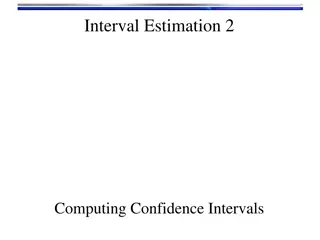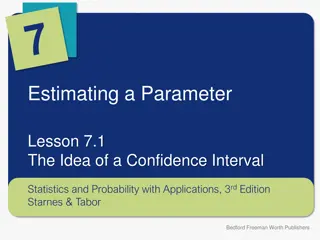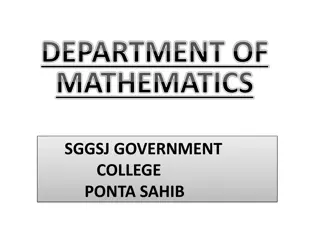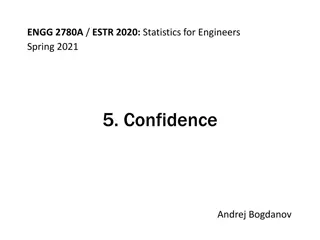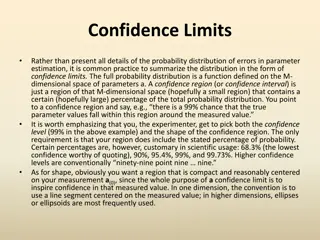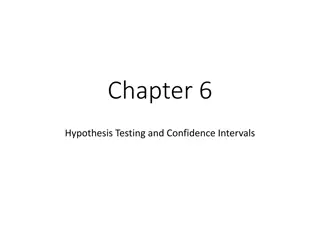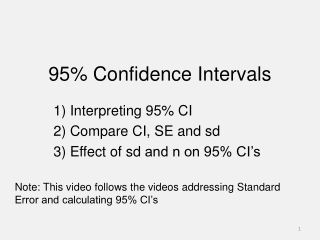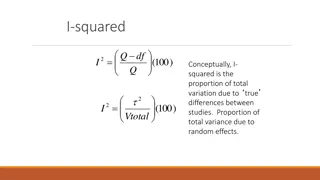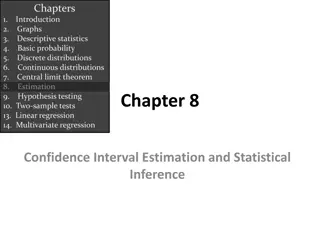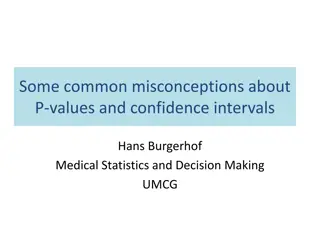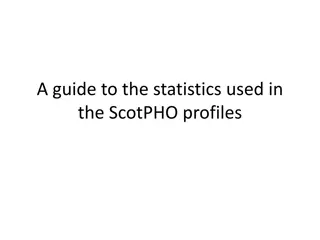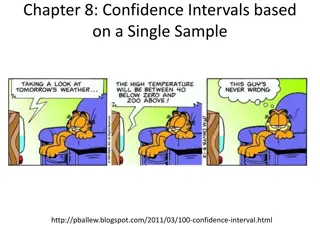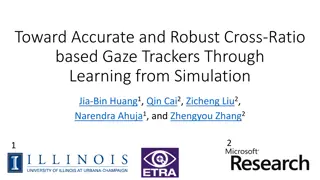Understanding Estimation and Confidence Intervals in Statistics
Explore the concepts of point estimates and interval estimates in statistics. Learn how to construct confidence intervals for the mean and proportion, consider the finite population correction factor, choose an appropriate sample size, and calculate confidence levels using known population standard deviation. Discover the factors affecting confidence intervals and how they determine the width of the interval.
Download Presentation

Please find below an Image/Link to download the presentation.
The content on the website is provided AS IS for your information and personal use only. It may not be sold, licensed, or shared on other websites without obtaining consent from the author. Download presentation by click this link. If you encounter any issues during the download, it is possible that the publisher has removed the file from their server.
E N D
Presentation Transcript
Estimation and Confidence Intervals Chapter 8
Goals Explain what is point estimate and interval estimate (confidence interval); Construct confidence interval for mean, and for proportion; Applying finite-population correction factor; Choose an appropriate sample size;
Point Estimate and Interval Estimate A point estimate is a statistic computed from a sample and is used to estimate a population parameter. Example: the sample mean, , is a point estimate of the population mean, ; X
Point and Interval Estimates An interval estimate (confidence interval) is a range of values within which the analyst can declare, with some confidence, that the population parameter lies. Examples: watching TV between 4 to 6hrs per day; using cell phones between 100 to 150 minutes per month.
Construct confidence interval-with known Population Standard Deviation ( ) The confidence interval for the population mean is constructed using the following equation x z n sample mean x z - particular a for value confidence level z population the standard deviation number the of observatio in the ns sample n
Finding z-value for 95% Confidence Interval The area between Z = -1.96 and z= +1.96 is 0.95
Confidence Levels and z values Confidence level Z value 99% 2.58 95% 1.96 90% 1.645
Factors Affecting Confidence Intervals The factors that determine the width of a confidence interval are: 1. The sample size, n: higher n leads to smaller interval. 2. The variability in the population , lower leads to smaller interval. 3. The desired level of confidence, lower confidence leads to smaller interval.
EXAMPLE Population Standard Deviation ( ) Known A survey was taken of companies that do business with firms in India. One of the questions on the survey was, How many years has your company been trading with firms in India? A random sample of 44 responses yielded a mean of 10.455 years. Suppose the population standard deviation for this question is 7.7 years. What is the population mean? What is a reasonable value to use as an estimate of the population mean? What is a reasonable range of values for the population mean? construct a 90% confidence interval for the mean number of years 1. 2. 3.
You Try It Out! The mean daily sales are $2000 for a sample of 40 days at a fast-food restaurant. The standard deviation of the population is $300. a) What is the estimated mean daily sales of the population? What is this estimate called? b) What is the 99 percent confidence interval?
Population Standard Deviation () Unknown As long as the population is normally distributed, we can use the sample standard deviation s as an estimate of , and use t distribution to replace z distribution, when computing confidence interval.
Confidence Interval for Population Standard Deviation ( ) Unknown
Characteristics of the t distribution It is a continuous distribution. It is bell-shaped and symmetrical. It is more spread out and flatter at the centre than the standard normal distribution. As the sample size increases, however, the t distribution approaches the standard normal distribution, because the errors in using s to estimate decrease with larger samples. 1. 2. 3.
Comparing the z distribution and the t distribution
Summary When to use z distribution and when to use t distribution? When population is normally distributed and population standard deviation is unknown, t distribution should be used. When population standard deviation is known, then z distribution may be used.
EXAMPLE t distribution A tire manufacturer wishes to investigate the tread life of its tires (normally distributed). A sample of 10 tires driven 80 000 km revealed a sample mean of 0.81 cm of tread remaining with a standard deviation of 0.23 cm. Construct a 95 percent confidence interval for the population mean. Would it be reasonable for the manufacturer to conclude that after 80 000 km the population mean amount of tread remaining is 0.76 cm? Given in the problem : = 10 n = . 0 81 x = . 0 23 s Compute the C.I. using the unknown) is - dist. (since t s X t n
You Try It Out! The owner of Britten s Egg Farm wants to estimate the mean number of eggs laid per chicken. A sample of 20 chickens shows they laid an average of 20 eggs per month with a standard deviation of 2 eggs per month. Assume that the population (number of eggs) is normally distributed, develop the 95 percent confidence interval? Would it be reasonable to conclude that the population mean is 21 eggs? What about 25 eggs?
Finite Population Correction Factor When n/N < 0.05, the correction factor (approaches 1) is ignored ; Otherwise, it is N n = FPC 1 N N n x z 1 N n s N n x t 1 N n n 1 ( p ) p N n p z 1 N
EXAMPLE Finite Population Correction Factor Given in Problem: N 250 n 20 s - $75 There are 250 families in a small Alberta town. A poll of 20 families reveals the mean annual church contribution is $450 with a standard deviation of $75.3 (assume the population is normally distributed). 1. Develop a 90 percent confidence interval for the population mean. 2. Interpret the confidence interval. Since n/N = 20/250 = 0.08, the finite population correction factor must be used. The population is normally distributed and population standard deviation is not known therefore use the t- distribution. t=1.685,
EXAMPLE Finite Population Correction Factor s N n X t 1 N n 75 $ 250 20 = 450 $ t 250 1 20 75 $ 250 20 = . 1 450 $ 685 250 1 20 = 450 $ 28 $ 26 . 9237 . = 450 $ 27 $ 16 . = 477 ,$ 84 . 422 ($ 16 . ) likely tha is It population t the mean more is than $422.84 but less than $477.16. population the could y, another wa it put To mean $445? be Yes, but it is not within th is $445 value the because $410 is it t likely tha confidence e not within is $410 and interval confidence the interval.
You Try It Out! The attendance at the Foresters Falls baseball game last night was 400. A random sample 50 of those in attendance revealed that the mean number of soft drinks consumed per person was 1.86 with a standard deviation of 0.50. Develop a 99 percent confidence interval for the mean number of soft drinks consumed per person.
Choosing An Appropriate Sample Size In general, as sample size increases, the sample estimates are more accurate at a higher cost. What sample size to use? There are 3 factors that determine the size of a sample 1. The degree of confidence selected 2. The maximum allowable margin error 3. The population standard deviation
EXAMPLE Sample Size for a Population Mean A student in business administration wants to determine the mean amount members of city councils in large cities earn per month as remuneration for being a council member. The error in estimating the mean is to be less than $100 with a 99 percent level of confidence. The student found a report by the Department of Labour that estimated the standard deviation to be $1000. What is the required sample size? 2 z = n E 2 ( 2.58 )($ , 1 000 ) = 100 $ = 2 ( 25 ) 8 . = 665 64 . = 666


